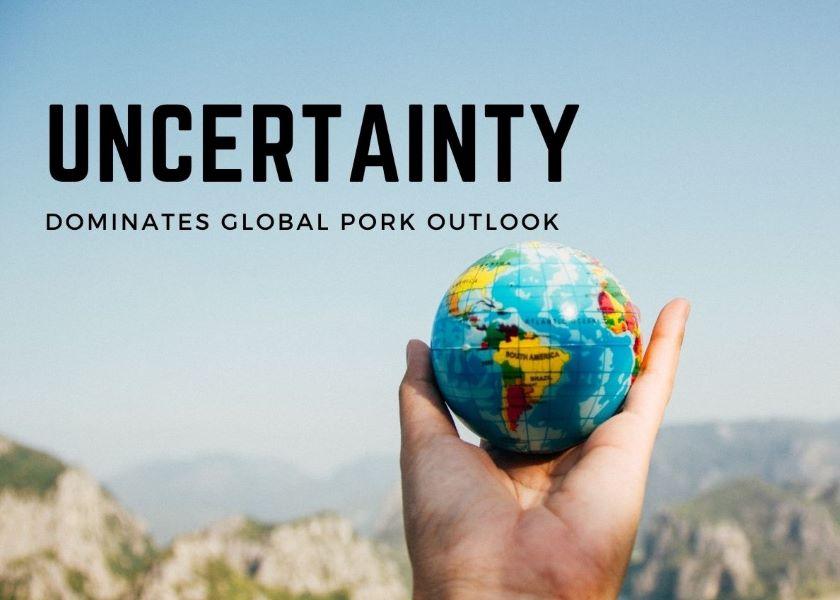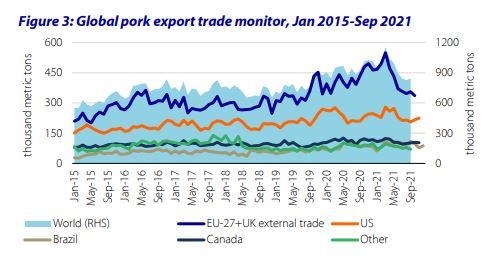The COVID-19 Wild Card: Uncertainty Dominates Global Pork Outlook

COVID-19 continues to be the wild card in the global pork industry – from both a production and a demand standpoint, says Chenjun Pan in Rabobank’s latest Q1 2022 Pork Quarterly report. But the threat of African swine fever (ASF) outbreaks, rising input costs and declining global pork imports and exports are all global industry concerns moving into Q2, analysts say.
Pandemic Continues to Challenge Pork Supply Chain
Although the evolution of the COVID-19 pandemic remains uncertain, most consumers are more experienced in dealing with the possible dynamics, says Pan, senior analyst-animal protein with Rabobank. Consumers are stocking refrigerators, eating healthy foods and saving for the future.
“But the long tail of the slowing global economy will have more visible consequences in 2022: slower income growth, rising unemployment and lower confidence in the future,” Pan says. “However, price inflation of consumer goods, driven by rising input costs, inefficiency in supply chains and labor issues, will put extra pressure on consumers’ wallets.”
Pork prices increased marginally in late 2021, but they remain below 2021 peak levels today. Pork is not immune to potential disruptions, the report notes, but it could benefit from consumers trading down and having less discretionary income.

Source: Rabobank Q1 2022 Pork Quarterly
Biosecurity Remains Top-of-Mind
Swine health continues to be of utmost importance as diseases remain an uncertainty throughout the world, with varying impacts by region. In Europe, ASF has recently spread to new countries. In Asia, ASF continues to work its way throughout China, but with a much lower impact than in 2020, Pan says. Both Vietnam and the Philippines experienced increased ASF cases in the winter resulting in more culling in certain areas.
Source: Rabobank Q1 2022 Pork Quarterly
“The complexities of the outbreaks led to some panic slaughtering, which caused price volatility,” Pan says. “The pace of herd restocking in 2022 will be slow in both countries.”
Slowing Global Trade
ASF continues to spread throughout some Asian countries, but reports show many Asian countries are picking up speed when it comes to pork production. In China, Vietnam and the Philippines, Pan says the declining demand for imports is a result of better domestic production. Meanwhile, Thailand will likely increase imports to cover shortages caused by the deadly viral disease of pigs that has induced herd liquidations.
“While global import demand will likely decline in 2022, we expect pork prices to stay resilient given high production costs,” Pan says. “Among exporters, U.S. exports particularly to Japan and South Korea, should move higher in 2022 on more competitive prices.”
Both the U.S. and Canada are targeting Mexico as labor for further processing remains an issue in both markets. Mexico will likely grow exports, the report notes, as it has gained access to several markets in recent months.
Who Will Handle the Work Load?
Labor issues aren’t going away in North America and some European countries, especially because of COVID-19 restrictions. Even as some of the latest restrictions ease, Rabobank expects labor to remain challenging.
“Double-digit increases in wages and more attractive benefits packages are helping stabilize turnover for some plants but leave costs structurally higher for packers,” Pan says. “Even if plants can maintain slaughter rates, many are unable to realize the full value of the carcass.”
She also expects China to encounter labor shortages over the long term given the declining birth rate. Products that require less labor will grow faster than labor-intensive products.
Input costs will stay inflated in 2022, analysts predict, between dry weather in Brazil, 2021 flooding in China, low inventory around the globe and the uncertain impact of the Tonga volcanic eruption.
More from Farm Journal's PORK:
Room for Optimism in the Lean Hog Market, Payne Says
5 Pork Industry Opportunities: Focus on Production Efficiency








